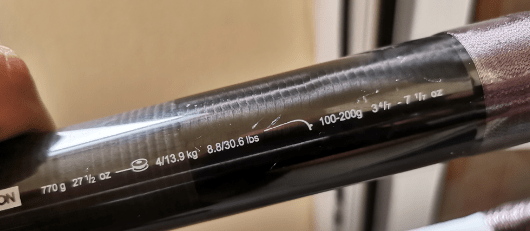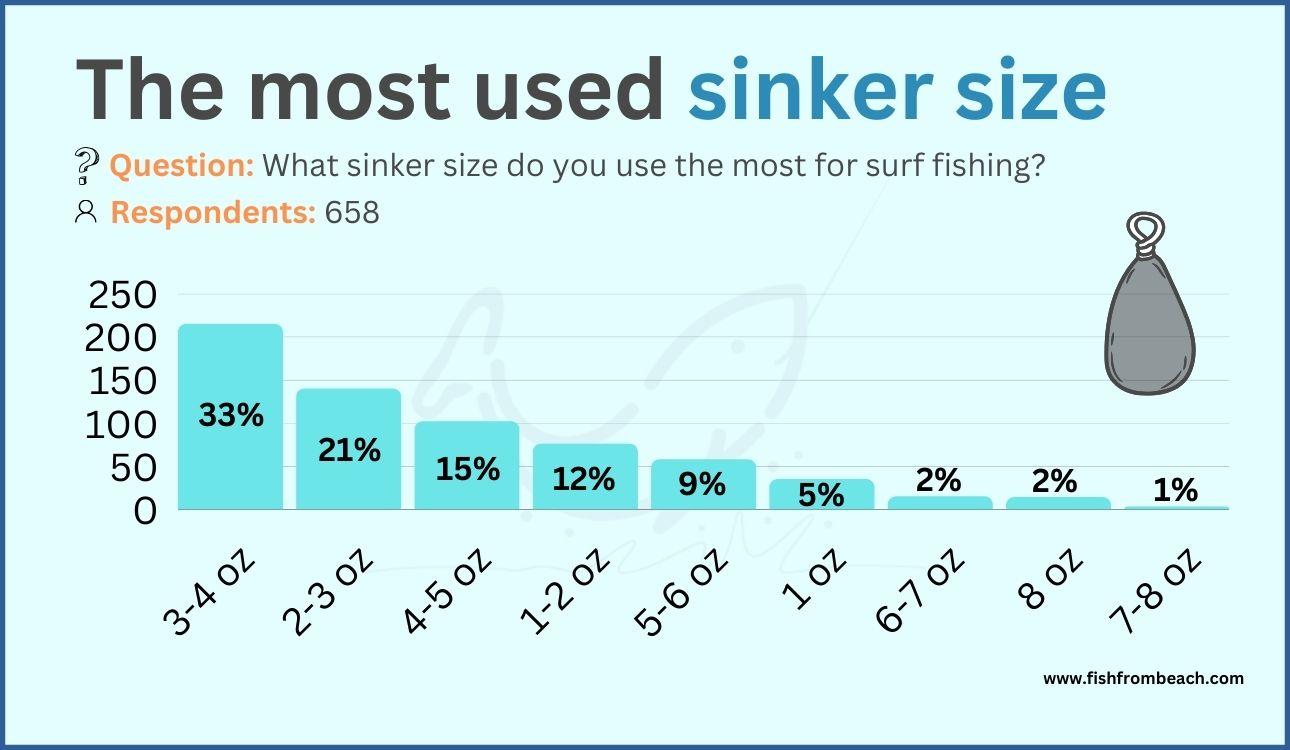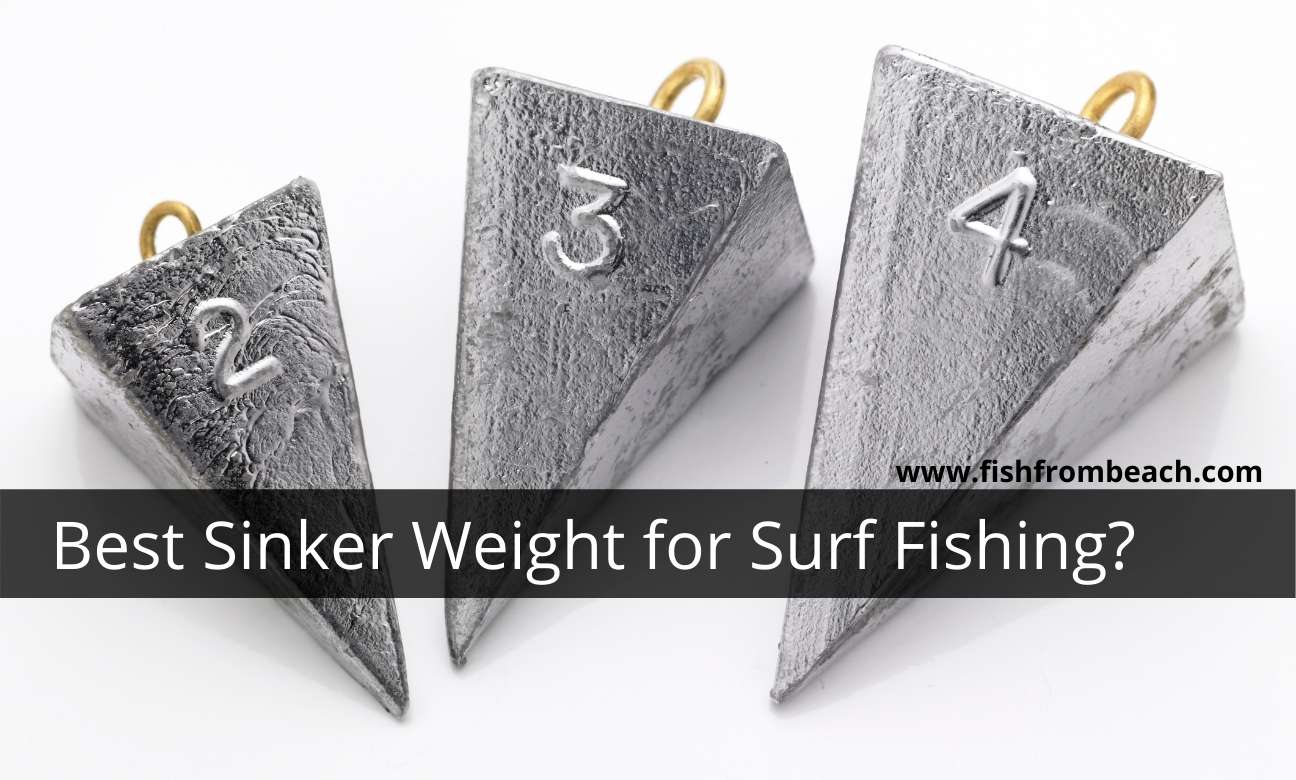One of the main concerns when beach fishing is how to keep the bait in the bite zone and avoid being drifted by strong currents and tidal forces.
That’s why your choice of sinker when surf fishing should be supported by a lot of rational thought and reasoning.
The goal is to choose a sinker that keeps your offering where the fish hold and feed, while still ensuring a productive and comfortable fishing experience.
In this article, we will cover all you need to know about surf fishing sinkers, how much weight you should cast into the surf, and which sinker shape yields the best results.
A quick answer
Pyramid sinkers weighing 3-4 oz are the overall best choice for surf fishing. Pyramid sinkers dig deeper into the seabed, providing better stability and more control over bait placement. Spider sinkers are also a good choice when fishing in snaggy bottoms.

What makes a good sinker for surf fishing?
It stays at the bottom: Most game fish tend to be bottom feeders and prefer to pick up their food from the seabed. As a result, the best sinker for surf fishing should pull your baited rig to the bottom and prevent it from getting into shallow depths. Generally speaking, even a very light sinker (say ¼ oz) can reach the bottom. However, if you plan to use rigs with multiple hooks and many snoods and extensions, then you should consider increasing the weight. Worth noting here that monofilament leaders have a better floating capability, which can pull your sinker up if it’s not heavy enough.
It sinks quickly to the bottom: Yes, you must use enough weight to stay at the bottom, but it’s also important to get there as quickly as possible. In rough surf conditions, the current can drive your rig a long distance between the moment it enters the water and the moment it reaches the sea floor. As a result, the bait can deviate too far during that short period of time. Therefore, your sinker should be heavy enough to reduce the distance at which it will be deviated. Normally, this should not be a source of concern in calm surf conditions. But when the current is strong, the more time your terminal tackle takes to reach the floor, the more it will deviate from where it was intended to be.
It resists strong currents: It is frustrating when the current takes your bait away from where you think the fish hold. The main reason why this happens is a too-light sinker that cannot withstand the movement of water. Another factor is the shape of the sinker and its ability to securely grip the underwater terrain.
It casts far enough: A good sinker for surf fishing is also a sinker that casts far. The heavier the lead, the more force it generates during the load, and the farther it goes in the surf. As a rule of thumb, your sinker should be big enough to ensure a minimum casting distance of 30 yards.
It respects your rod guidelines: Your pole can only support a certain casting weight. Therefore, your sinker needs to be lighter than that threshold to protect the rod. More about this in a few moments.
The best sinker weight for surf fishing
Now that we know what makes a good sinker, let’s address the weight question. How heavy should your sinker be?
Why too much weight is bad?
Well, first of all, remember that your rod can only support a limited casting weight.
Where to find this information? On the rod itself, usually next to the handle.
Pick up any modern fishing rod and you will find a set of letters and numbers written on it.
Some of these numbers and letters refer to the rod’s height, action (bending type), power (resistance to bending), and recommended line size.
But, there is usually also an indication of the recommended casting weight.
For example, the recommended casting weight for the rod below is between 3 (4/7) and 7 (1/7) oz.

Does exceeding this range risk breaking the pole? Not necessarily on the first cast, but rigorous power casting with too much weight will gradually damage the rod until it breaks one day.
On top of that, the figures stated one the rod is the recommended range for optimal performance in terms of balance, sensitivity, hooksetting, and bite detection.
Yes, using too much weight while surf fishing makes it difficult for anglers to detect bites. Why? Because the heavier the rig, the harder it is for the fish to move it, and, therefore, the less vibration they send you down the line. What does this imply? It implies that you can detect bites from large predators with aggressive feeding, but small fish with subtle bites will give you very few clues.
Why too low weight is bad?
While weights that are too heavy put rods under stress and reduce sensitivity, sinkers below the optimal weight can have a more serious impact on performance and productivity.
The main thing to remember here is that fish only hold where it’s most safe to swim and feed. As a result, they are likely to concentrate in particular areas and compete over territory and the limited amount of food and cover.
Your role as a surf angler is therefore to identify these zones, cast in their direction, and ensure that your offering stays there until you retrieve the line.
This is where too-light weights come short.
During strong currents and windy days, they usually fail to keep your terminal equipment where you want it to be, allowing it to drift away to areas with no action. The outcome of this is obvious: A mediocre fishing score.
A heavier sinker gives you more stability and helps keep your bait where fish are most abundant and feel safe to eat.
A good weight in surf fishing is therefore a determining factor for success.
Sinkers that are too light are also inconvenient when trying to cast far. This is not always a critical issue, but it’s always good to be able to try out distant spots when the nearby ones give poor results.
So what is the optimal weight for surf fishing?
So what is the happy middle here? What weight works best for surf fishing?
Well, as always, the answer is: IT DEPENDS.
It depends on the surf and weather conditions and the strength of the current.
For a calm beach and weak current, 1 to 2 ounces is usually all you need to stay stable in the strike zone.
However, in more choppy waters you may need to use up to 6-8 oz to avoid being pushed around all the time.
From firsthand experience, 3-4 oz weights work well in most cases and provide adequate stability.
This is the range that I use the most when surf fishing and I rarely need to upsize the lead.
What I recommend though is to always bring one or two weights of each size from 2 to 10 oz.
Start your day with a 3-4 ounce sinker, then gradually increase the weight if the current asks for it.
Among 658 surf anglers that participated in our surf fishing survey, the most commonly used sinker size is 3-4 oz (32.67% of the votes), followed by 2-3 oz (21.28% of the votes).
There was also a notable preference for 4-5 oz (15.50%) and 1-2 oz (11.55%) sinker sizes.
Other sizes received less preference, with heavier sinkers being less popular among the respondents.

What sinker shape for surf fishing?
Pyramid and spider sinkers
Pyramid sinkers are arguably the most used sinkers for surf fishing.
That’s because they offer a firm grip on the seabed, maintaining control over bait placement no matter how rough the surf is.
Their structured shape also makes them less prone to rolling and bouncing on the seabed during strong currents. This helps to keep your bait where you want it to stay.
Another common sinker for surf fishing is the spider sinker which features four wires that effectively penetrate sandy bottoms and offer increased resistance against rough water conditions.
Spider sinkers are also great when fishing rocky bottoms because the 4 wires snap open and fold back under pressure, helping to free the line when it gets stuck between rocky clusters.
Egg and bank sinkers
The best thing about egg sinkers and bank sinkers is their aerodynamic shape which allows for greater casting distances.
Their smooth, edgeless shape cuts better in the air and therefore travels longer during casts. Conversely, weights with edgy shapes (like pyramid sinkers) receive more air resistance and thus drop into the water earlier.
The shape of egg and bank sinkers also gives them the ability to flip and roll over the seabed easily, making them less prone to snags and tangles.
That’s why they are often recommended when surf fishing rough grounds and rocky structures. They simply escape underwater obstacles more effectively.
This ability to bounce and rollover can also be useful to attract fish. Some fish species prefer live prey and moving food. Aerodynamic sinkers help to draw the attention of such fishes because they keep rolling and bouncing on the underwater terrain and puffing up sand.
Another interesting thing about egg sinkers is the hole in their center.
This hole allows the weight to slide along the line, which gives fish a weaker feeling of resistance when they tug on your bait.
This makes them feel safer and more comfortable around your bait and encourages them to make the final strike.
Other sinkers that cannot slide along the line do not allow this. As a result, fish feel the weight and the resistance as soon as they start pulling on your bait, which worries them more about your offer.
So which shape to choose?
Egg and bank sinkers are good for surf fishing, but they’re usually not the best option. I believe their disadvantages outweigh the benefits they provide and therefore should be avoided unless you have a good reason to use them.
Stability in the surf is a critical factor and a deal breaker. In other words, you should never let the current dictate where you deploy your baits. As mentioned earlier, your role as a surf angler is to read the beach properly identify the areas to target, and make sure your offering sticks there for the entire cast. That’s where egg and bank sinkers come short.
During strong currents, they usually fail to resist the movement of water and, as a result, drift away from the area where you believe fish exist.
That’s why I believe pyramid and spider sinkers are the best for beach fishing. Their structured shapes dig deeper into the ground and help maintain the stability of your terminal equipment.
Spider sinkers go a step further and incorporate metal wires to solve the snagging problem when fishing mixed seabeds.
How to use sinkers for surf fishing?
Well, it depends on which rig you plan to use. There are usually only 2 cases here and each serves a different purpose:
Tie the sinker before the bait
Like with the fish finder rig and the Carolina rig. This setup allows the bait to swing freely with the current, which can be quite attractive and eye-catching for the fish.
Another advantage of this configuration is that it gives fish a weaker feeling of weight, which encourages them to stay around suspecting nothing until one of them gets caught.
The fish finder rig takes this a bit further by incorporating a sliding sinker that allows fish to work the bait without feeling any weight.
Tie the sinker after the bait:
This configuration is generally used when you want to use multiple hooks like with the flapper rig and the high/low rig.
This is also the way to go when you want to try different depths at the same time to target both bottom feeders and fish that prefer suspended food.
Sinkers at the end of rigs also tend to tangle less often on rough grounds. It is therefore a good configuration to consider when fishing mixed bottoms and seagrass beds.
Note (*): If you make a purchase through links from this website, we may get a small share of the sale from Amazon or other similar affiliate programs.
Surf Fishing Survey
Help us provide you with better content by answering simple questions about your surf fishing experience and knowledge.
We will put the collected responses together and turn them into valuable information that will help you catch more fish from shore 😉
Note: No personal information will be collected with your answer.

